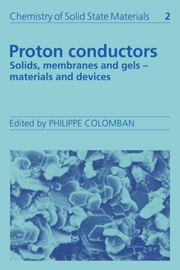Book contents
- Frontmatter
- Contents
- List of contributors
- Preface
- Symbols
- I HYDROGEN BOND AND PROTONIC SPECIES
- II MATERIALS: PREPARATION, STRUCTURES AND PROPERTIES
- III PROTON DYNAMICS AND CHARGE TRANSPORT
- 21 Incoherent neutron scattering studies of proton conductors: from the anhydrous solid state to aqueous solutions
- 22 NMR studies of local motions in fast protonic conductors
- 23 Vibrational spectroscopy of proton conductors
- 24 Raman spectroscopic studies of proton conductors
- 25 Frequency dependent conductivity, microwave dielectric relaxation and proton dynamics
- 26 Measuring the true proton conductivity
- 27 D.c. techniques and a.c./d.c. combination techniques
- 28 NMR in gels and porous media
- IV PROTON DIFFUSION MECHANISMS
- V DEVICES
- Index
27 - D.c. techniques and a.c./d.c. combination techniques
Published online by Cambridge University Press: 04 May 2010
- Frontmatter
- Contents
- List of contributors
- Preface
- Symbols
- I HYDROGEN BOND AND PROTONIC SPECIES
- II MATERIALS: PREPARATION, STRUCTURES AND PROPERTIES
- III PROTON DYNAMICS AND CHARGE TRANSPORT
- 21 Incoherent neutron scattering studies of proton conductors: from the anhydrous solid state to aqueous solutions
- 22 NMR studies of local motions in fast protonic conductors
- 23 Vibrational spectroscopy of proton conductors
- 24 Raman spectroscopic studies of proton conductors
- 25 Frequency dependent conductivity, microwave dielectric relaxation and proton dynamics
- 26 Measuring the true proton conductivity
- 27 D.c. techniques and a.c./d.c. combination techniques
- 28 NMR in gels and porous media
- IV PROTON DIFFUSION MECHANISMS
- V DEVICES
- Index
Summary
Introduction
The a.c.-impedance method described in the previous chapter is often employed to characterize the electrical properties of solid proton conductors. The method gives a rapid answer to the question ‘does the material under investigation conduct electricity’ and the method is not critical with respect to size, shape and quality of the sample used.
If the a.c.-impedance method shows that the material is a conductor there still remain the following questions.
(1) Is the material an electronic or an ionic conductor or a mixture of both?
(2) Which kind of ion is responsible for the conduction in the case of several possible moving ions, e.g. is CsHSO4 a cesium ion conductor, a protonic conductor, a sulphate/hydrogensulphate conductor or a mixture of some or all of these possibilities?
(3) Are the materials in the case of polycrystalline materials true bulk conductors or do they possess surface conductivity, where the conduction takes place in the boundary phase between the individual grains?
(4) If proton conduction is verified, is the conduction mechanism then proton hopping between partially occupied proton sites accompanied by a reorganization of the anion lattice or is the mechanism proton transport by a carrier (e.g. water, hydrazine or ammonia) which possibly counter-diffuses when the proton is discharged at the cathode (vehicle mechanism)?
Only the third question can be answered directly on the basis of simple a.c. measurements.
- Type
- Chapter
- Information
- Proton ConductorsSolids, Membranes and Gels - Materials and Devices, pp. 418 - 431Publisher: Cambridge University PressPrint publication year: 1992
- 3
- Cited by



